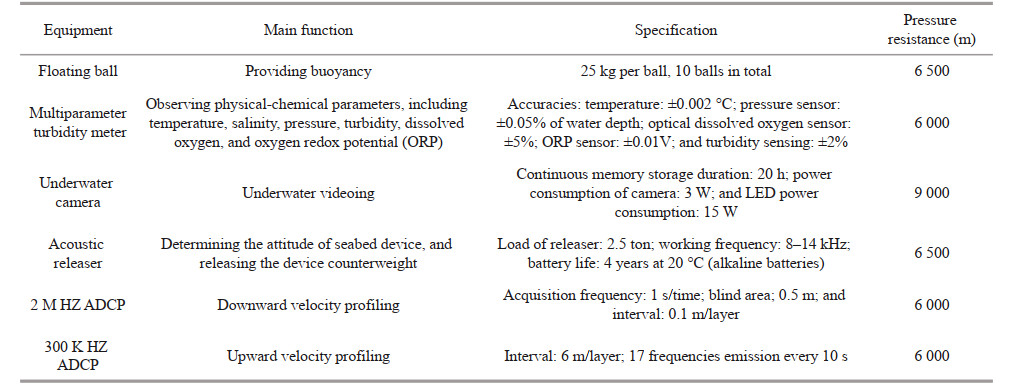Institute of Oceanology, Chinese Academy of Sciences
Article Information
- LI Bowen, JIA Yonggang, FAN Zhihan, LI Kai
- The profile of sound speed and dissolved oxygen in the polymetallic nodules depositional area in the Western Pacific
- Journal of Oceanology and Limnology, 41(6): 2090-2100
- http://dx.doi.org/10.1007/s00343-023-3061-1
Article History
- Received Apr. 5, 2023
- accepted in principle Jun. 1, 2023
- accepted for publication Jul. 18, 2023
2 Laboratory for Marine Geology, Qingdao National Laboratory for Marine Science and Technology, Qingdao 266100, China;
3 Shandong Provincial Key Laboratory of Marine Environment and Geological Engineering, Ocean University of China, Qingdao 266100, China
There are 10%–30% of the seabed covered with polymetallic nodules rich in iron, cobalt, nickel, copper, titanium, and other metal elements (Hein et al., 2020). The polymetallic nodules resource potential in the Clarion-Clipperton Zone (CCZ) of the Pacific Ocean alone is equivalent to 5–10 times of the total global terrestrial resource reserves (Glasby, 2000; Hein et al., 2013; Miller et al., 2018). These metal resources are precious in the development of modern society. As a result, research on deep-sea polymetallic nodules has been done since 1960s in developed countries, led by the US, Germany, and Japan (Amos and Roels, 1977; Ozturgut et al., 1981). However, due to economic, technological, political, environmental, and other constraints (Petersen et al., 2016), research on polymetallic nodules has not yet reached the stage of commercial exploitation. Nonetheless, polymetallic nodules are still the most promising target for commercial exploitation of deep-sea metal resources (Sparenberg, 2019; Hein et al., 2020; Toro et al., 2020) and are the main representatives of current deep-sea mining research.
Deep-sea polymetallic nodules are generally distributed in abyssal plains in water depth of 4 000–6 000 m. CCZs are most widely distributed in the eastern Pacific, where the average abundance of polymetallic nodules is about 15 kg/m2 (Roy et al., 1990). It is also distributed in the Indian Ocean, the Cook Islands, and the Peruvian Basin (Beaudoin and Baker, 2013; Beaudoin et al., 2014) with average abundances of 5 kg/m2, 5 kg/m2, and 10 kg/m2, respectively (Liu et al., 2020). The deep-sea polymetallic nodule occurrence area is relatively deep, generally below carbonate compensation depth (CCD), the sediment consists mainly of soft silty clay. The whole landscape is relatively flat, but there are also small seamounts and hills. These small seamounts and hills not only affect the distribution of nodules (Liang et al., 2014; Li et al., 2021), but also affect the determination of collection paths and location of seabed mining vehicles during mining.
The engineering geology of the prospect is broadly divided into a large range, but does not consider the abundance of nodules, the physical and mechanical properties of the sediments, and the hydrodynamic conditions near the seabed (Lü et al., 2008; Tao et al., 2014; Kim et al., 2019). In addition, the spatial distribution of organisms has a certain regularity, which is also related to the distribution of polymetallic nodules (Wu et al., 2013; Kersten et al., 2019; Huang et al., 2020; Laroche et al., 2020). In future commercial mining, the dividing engineering geological units and mining units in mining areas are based on the above-mentioned specifications. With the development of technology, to improve survey efficiency, submarine cameras (Sharma et al., 2010) and acoustic reflection inversion (Perelman et al., 2021) were developed to obtain the submarine video image and acoustic reflection intensity.
Due to the impact of dissolved oxygen on biological productivity (Nicholson et al., 2015) and the widespread application of sound propagation in ocean research, the deep-sea structure, and its influencing factors of the both should be paid with attention. The concentration of dissolved oxygen in the open and coastal seas has been declining (Breitburg et al., 2018). Over the past 60 years, the estimated dissolved oxygen loss in the open seas has exceeded 2% (Schmidtko et al., 2017), which has raised concerns about the consequences of the expansion of anoxic zones (Paulmier and Ruiz-Pino, 2009). This is largely due to the deepening of the isodensity layer and the decrease in oxygen solubility associated with ocean warming (Sasano et al., 2015). Among them, the Eastern Tropical North Pacific (ETNP) is a large, continuous, enhanced minimum oxygen zone (OMZ), accounting for almost half of the total area of the world's minimum oxygen zone. Within the OMZ core (approximately 350–700-m depth), dissolved oxygen is usually near or below the analytical detection limits of modern sensors (~10 nmol/L) (Faull et al., 2020).
Sound propagation has been used in many important applications in the upper ocean and mixed layer (ML), including acoustic communication (Stojanovic and Preisig, 2009), navigation (Eustice et al., 2011), marine bioacoustics (Tyack, 2008), remote sensing (Sutton et al., 1993), sonar, marine resource exploration and many other marine fields (Heidemann et al., 2012; Ahmed and Younis, 2017). Current observations in the North Pacific have found a variable mixed layer acoustic duct with an average acoustic layer in the depth of 91 m (Colosi and Rudnick, 2020). In the actual marine physical environment, many marine environmental parameters affect the sound speed, including the relatively stable parameters, such as the seabed structure, ocean depth; and some dynamically changing parameters, such as marine biota, ocean currents, temperature, and salinity, where temperature changes have the most significant impact on sound speed (Wong and Zhu, 1995; Chen et al., 2016). However, the simulation of deep-sea sound speed mainly considers temperature and salinity factors, with less consideration given to other factors (Li and Zhai, 2022).
However, duo to the lacks in stable and safe deep-sea (the depth > 1 000 m) vertical profile observation systems and consequently in long-term in-situ observation data, the sound speed and dissolved oxygen and the other water environment factors in the deposition areas of polymetallic nodules remains poorly understood. Moreover, the International Seabed Authority requires that any mining activity must submit an environmental impact assessment report (EIAs), and the observation of the water quality background value of the polymetallic deposition area is the basis of its environmental impact assessment (Wedding et al., 2015). Therefore, we attempted to construct a deep-sea vertical profile observation system, and analyzed the water environment data in the polymetallic nodule deposition area obtained from this scheme, to enrich the understanding of the background value of the water environment in the polymetallic nodule deposition area.
2 METHODPolymetallic nodules appear on the surface of the seabed, mostly spherical, but also in other shapes such as rods, strips, and cauliflower (Mel'nikov et al., 2016). The diameter of the nodules is mostly 1–20 cm in density of 1.7–3 g/cm3, and the burial depths are generally < 30 cm, sometimes could reach below 30 cm (von Stackelberg, 1997).
In this study, we used the device equipped with multiple sensors to observe the profile of water environment elements in the nodule area (153.41°E, 7.48°N) in water depth of 5 700 m in the Western Pacific Ocean from 21:00, June 8, 2021 to 17:00 on June 9 (Fig. 1). The device is shown in Fig. 2. The height of device is 2.7 m, the weight in the air is 900 kg, and that in the water is 350 kg. The specifications of the equipment born on the device are shown in Table 1.
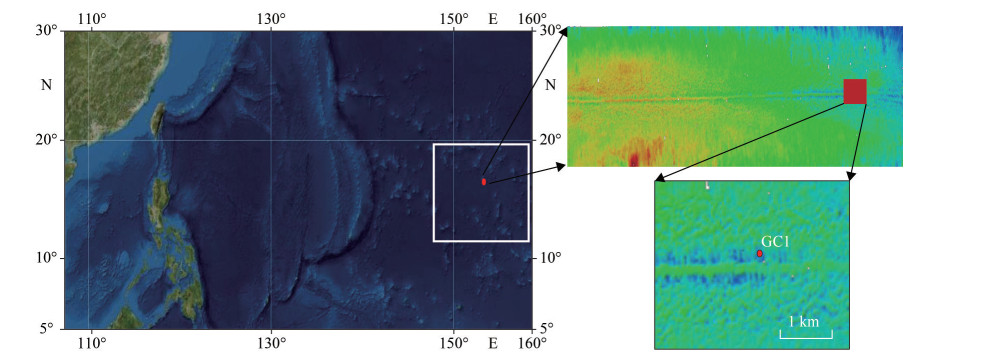
|
| Fig.1 The in-situ observation site (red spot) in the polymetallic nodule area (151.89°E, 18.77°N) in the Western Pacific Ocean |

|
| Fig.2 The device equipped with multiple sensors used to record the environmental conditions |
The device was placed by a cable and entered the water at 16:09 on August 8, 2021, attaching the seabed at depth of 5 700 m at 21:24 with the dropped velocity of 1 m/s. The lifting of the device began at 18:39 on August 9, 2021, and the device came out of the water at 20:24.
3 RESULT 3.1 Vertical environmental changeDuring the release and retrieval of the device, we observed environmental changes in vertical direction above the depositional area (Figs. 3–4). The device would disturb the water body during sinking, while during the retrieving, the water body beneath it would be affected. Thus, the current velocity at 6 m above the device is selected as the profile current velocity. The current velocity profiling during sinking showed that the current velocity at 1.2–1.6 m of the device was significantly greater than those in other depths (Fig. 3). Therefore, the current velocity at 1.7 m beneath the device was taken as the current velocity data during sinking.
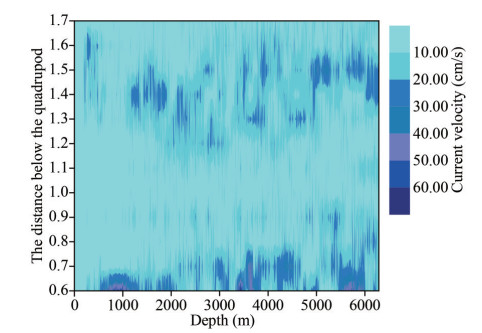
|
| Fig.3 The current velocity beneath the device in the device sinking process |

|
| Fig.4 The vertical changes of the environment recorded by the device in the polymetallic nodule depositional area during the device sinking |
During sinking and lifting, the sound speed in 0–500 m range showed a decreasing trend with water depth. When the water depth exceeds 500 m, the sound speed increases with the water depth increasing. The sound speed at 5 700 m near sea bottom increased to the same level as that in shallow water. The variation trends of conductivity and dissolved oxygen with depth were similar to that of sound speed.
The change of turbidity in water body was not obvious. Except for only a few sudden changes, the turbidity through water column remained mostly unchanged, and the average turbidity was 0 NTU. In redox potential, except for the sudden change at the beginning of releasing and bottom sitting, redox potential increased gradually with the increase of water depth before 500 m, while after 500 m it stabilized largely. The current velocity varied 20–60 cm/s, and its direction turned clockwise with depth.
3.2 Change of environment near bottom over timeIn this investigation, a 22-h in-situ observation of the polymetallic nodule deposition area was carried out from 21:00 on August 8 to 19:00 on August 9, 2021 at 5 754-m depth (Fig. 5). The observation shows that, during the observation period except for the moments of the device stroke and drawing, sediment resuspension at bottom bed occurred at 12:00 on August 8 only when current velocity increased to > 40 cm/s. After resuspension, the suspended sediment in the water body near the bottom bed was nearly 0 in most of the remaining time. In addition, dissolved oxygen decreased with time during the observation period at bottom, while the redox potential increased with time.
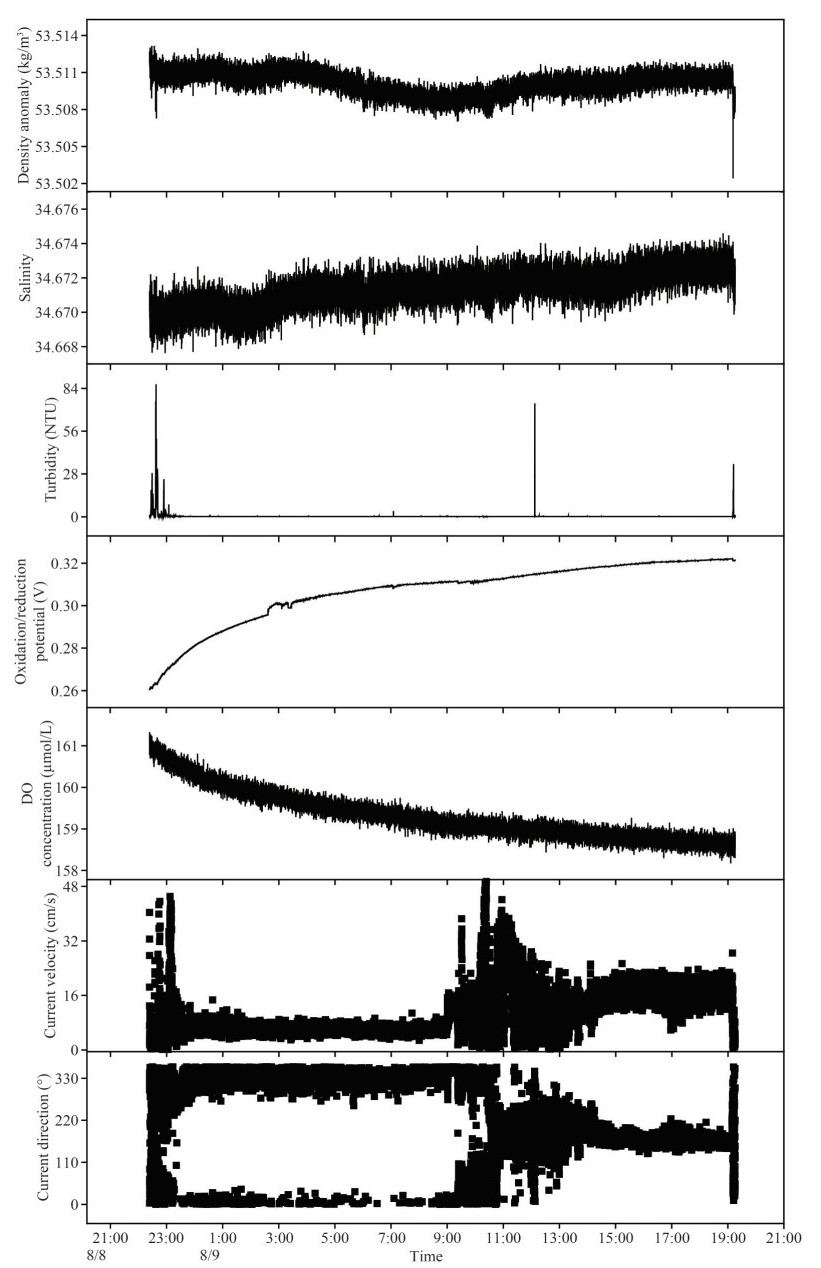
|
| Fig.5 The 22-h in-situ observation in the polymetallic nodule deposition area at sea bottom from 21:00 on August 8 to 19:00 on August 9, 2021 |
The sound speed in water was affected by temperature and pressure (Figs. 4 & 6), and decreased with water depth first and then increased, which may be due to that the sound speed in less than 840-m depth was mainly affected by temperature (Fig. 7a), while in water depth greater than 840 m, the sound speed was pressure dependent (Fig. 7b). Since there is no obvious change in temperature below the depth of 3 100 m, the relationship between sound velocity and pressure under the influence of temperature can be excluded by fitting the sound velocity and pressure at the depth of 3 100 m (Fig. 7c). Based on which the influence of pressure on sound speed could be ignored and the correlation between temperature and sound speed was obtained (Fig. 7d). This phenomenon indicates that in addition to temperature and salinity, the term of water pressure should also be considered in the prediction of deep-sea sound speed (Li and Zhai, 2022). Meanwhile, the conductivity was controlled by temperature (Fig. 8), it decreased with the decrease of temperature within 500-m water depth, and then stabilized beyond 500-m depth. We fitted the conductivity-temperature relationship, and the correlation coefficient is 0.99 (Fig. 8).
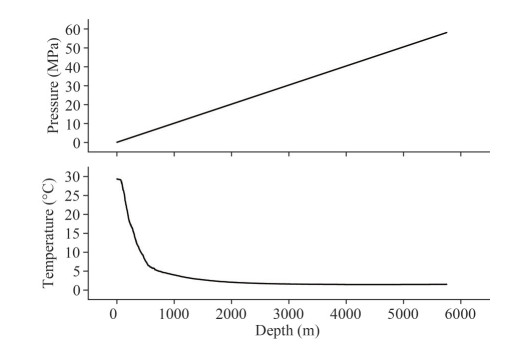
|
| Fig.6 The changes of pressure and temperature with depth |
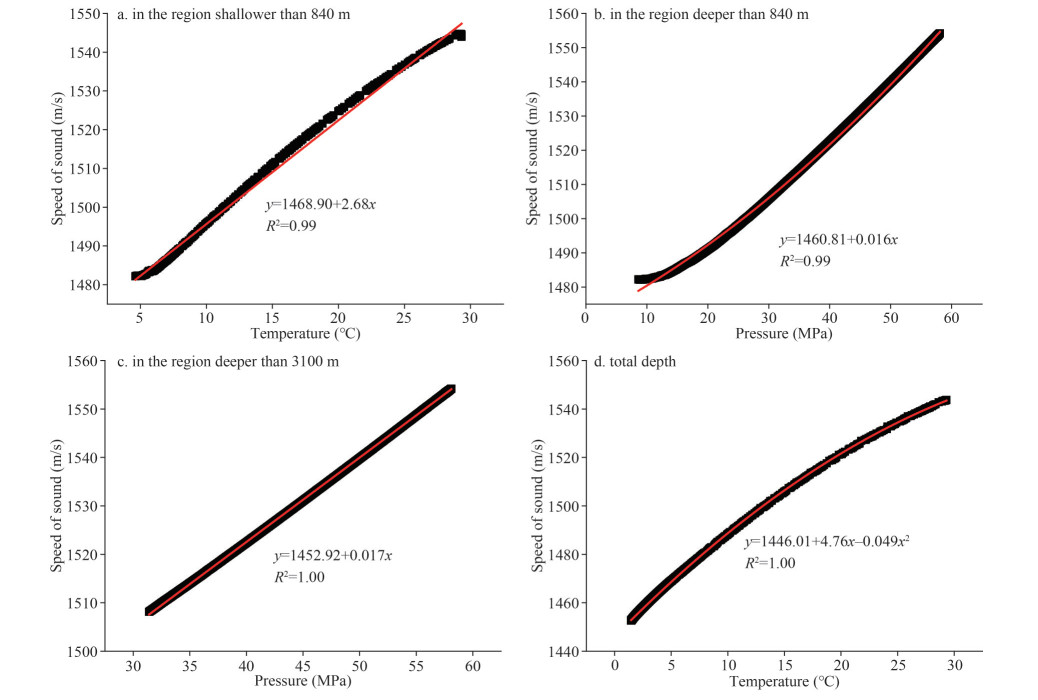
|
| Fig.7 The correlation between sound speed and temperature with the depth < 840 m (a), pressure with the depth > 840 m (b), pressure with the depth > 3 100 m (c), and the correlation between the sound speed that removes the effect of pressure and temperature in total depth (d) |

|
| Fig.8 The correlation between conductivity and temperature within 500-m water depth |
Observation results present that the change of dissolved oxygen was negatively correlated with the redox potential in the area less than 500-m water depth, the content of dissolved oxygen decreased with the increase of water depth (Fig. 4), while beyond 500 m and before landing at the bottom, the dissolved oxygen increased with water depth increase, and the redox potential remained basically unchanged. The correlation between dissolved oxygen and redox potential at sea bed in the depth of 5 700 m was negative (Fig. 9); after landing at the bottom, the negative correlation remained, and the correlation coefficient was 0.97. Because the seabed was covered with polymetallic nodules rich in iron, cobalt, nickel, copper, titanium, and other metal elements, local re-suspended sediments might react with dissolved oxygen, during which dissolved oxygen was depleted thus redox potential increased. The resuspension course might last for over 24 h, and the resuming time might be longer.
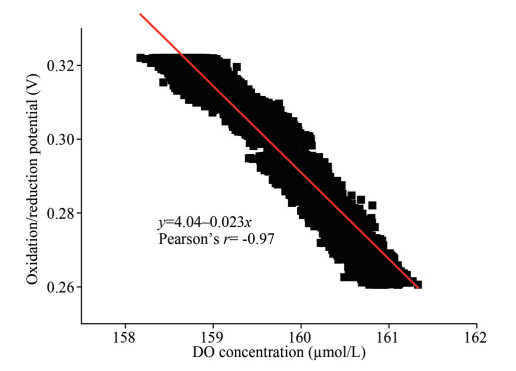
|
| Fig.9 The negative correlation between dissolved oxygen and redox potential |
The dissolved oxygen is affected by temperature, salinity, and pressure (Aras and Berkun, 2012; Hu et al., 2019). In this study, it decreased with water depth first and then increased. In the depths before 600 m, the dissolved oxygen and temperature decreased with depth increase (Figs. 4 & 6), which is in contrast to the decrease in oxygen solubility during ocean warming (Daisuke et al., 2015), indicating that the concentration of dissolved oxygen in this region was not limited by the decrease in oxygen solubility caused by ocean warming, and also contrast to saturated dissolved oxygen increase with water pressure increase (Fig. 10a) (Zeng et al., 2010).

|
| Fig.10 The dissolved oxygen change in the region of shallower than 600 m with water pressure (a) and conductivity (b) and the sound speed changes in the region of deeper than 600 m with water pressure (c) |
The dissolved oxygen concentration may be related to salinity (Luo et al., 2005). We fitted the dissolved oxygen and conductivity changes in the depth shallower than 600 m (Fig. 10c). The fitting results show the correlation between dissolved oxygen and conductivity is similar to that between salinity and conductivity (Liu, 2018) (Fig. 10b). Therefore, the dissolved oxygen was affected by salinity in the region shallower than 600 m, which also shows that the surface dissolved oxygen is affected by biochemical processes (Luo et al., 2005). However, in water deeper than 600 m, the change of dissolved oxygen was controlled by pressure. We fitted the correlation between dissolved oxygen and pressure in the water deeper than 600 m (Fig. 10c), showing that the dissolved oxygen was affected mainly by physical processes in the region deeper than 600 m as the oxygen minimum zone situated at 600 m (Zeng et al., 2010).
5 CONCLUSIONThe observation of the depositional area of polymetallic nodules in the Western Pacific showed that the vertical turbidity did not change significantly, except for only a few sudden changes, the turbidity of the water body remained basically unchanged, and its average turbidity was 0 NTU. Under the condition of no external influence, the suspended sediments in this area have little influence on the water environment.
The sound speed in the water body of the polymetallic nodule deposition area in the Western Pacific was affected by mainly temperature and pressure, and decreased with water depth within 840 m and then increased beyond 840 m as pressure took the control. In addition, the sound speed was negatively related to temperature, and similarly to conductivity, indicating that the conductivity was controlled by temperature. The correlation between sound velocity (s) and pressure (p) is s=1452.92+ 0.017p, and the correlation between sound speed and temperature (t) is s=1416.01+4.76t–0.049t2.
The dissolved oxygen was affected by physical processes in the region of > 600-m depth, and the surface dissolved oxygen was affected by biochemical processes in the region of < 600-m depth, indicating the oxygen minimum zone was in the depth around 600 m. The surface sediments rich in various metals might react with dissolved oxygen in the water body after resuspension, resulting in reduced dissolved oxygen and increased redox potential. This environmental impact caused by a single sediment re-suspension could last for 24 h or more.
Being limited by instruments, this observation system can monitor mainly some physical and chemical properties of water including temperature, turbidity, sound speed, redox potential, and resistivity. Additional to this work, future works shall focus on ecological indicators such as chlorophyll, nitrogen, and phosphorus.
6 DATA AVAILABILITY STATEMENTThe datasets generated and/or analyzed during the current study are available from the corresponding author on reasonable request.
7 ACKNOWLEDGMENTSpecial thanks go to Zhihan FAN and Kai LI from Ocean University of China.
Ahmed A, Younis M. 2017. Distributed real-time sound speed pro fi ling in underwater environments. In: Proceedings of the 2017 IEEE International Conference on Communications (ICC). IEEE, Paris, France. p. 1-7, https://doi.org/10.1109/ICC.2017.7997485.
|
Amos A F, Roels O A. 1977. Environment aspects of manganese nodule mining. Marine Policy, 1(2): 156-163.
DOI:10.1016/0308-597X(77)90050-1 |
Aras E, Berkun M. 2012. Effects of tailwater depth on spillway aeration. Water SA, 38(2): 307-312.
DOI:10.4314/wsa.v38i2.16 |
Beaudoin Y, Bredbenner A, Baker E, et al. 2014. Wealth in the oceans: deep sea mining on the horizon?. Environmental Development, 12: 50-61.
DOI:10.1016/j.envdev.2014.07.001, |
Beaudoin Y C, Baker E. 2013. Deep sea minerals: manganese nodules, a physical, biological, environmental and technical review. Secretariat of the Pacific Community, Nouvelle-Calédonie. p. 43-49, https://www.researchgate.net/publication/260596851. ISBN: 978-82-7701-119-6.
|
Breitburg D, Levin L A, Oschlies A, et al. 2018. Declining oxygen in the global ocean and coastal waters. Science, 359(6371): eaam7240.
DOI:10.1126/science.aam7240 |
Chen C, Lei B, Ma Y L, et al. 2016. Investigating sound speed profile assimilation: an experiment in the Philippine Sea. Ocean Engineering, 124: 135-140.
DOI:10.1016/j.oceaneng.2016.07.062 |
Colosi J A, Rudnick D L. 2020. Observations of upper ocean sound-speed structures in the North Pacific and their effects on long-range acoustic propagation at low and mid-frequencies. The Journal of the Acoustical Society of America, 148(4): 2040-2060.
DOI:10.1121/10.0002174 |
Eustice R M, Singh H, Whitcomb L L. 2011. Synchronous-clock, one-way-travel-time acoustic navigation for underwater vehicles. Journal of Field Robotics, 28(1): 121-136.
DOI:10.1002/rob.20365 |
Faull L M, Mara P, Taylor G T, et al. 2020. Imprint of trace dissolved oxygen on prokaryoplankton community structure in an oxygen minimum zone. Frontiers in Marine Science, 7: 360.
DOI:10.3389/fmars.2020.00360 |
Glasby G P. 2000. Lessons learned from deep-sea mining. Science, 289(5479): 551-553.
DOI:10.1126/science.289.5479.551 |
Heidemann J, Stojanovic M, Zorzi M. 2012. Underwater sensor networks: applications, advances and challenges. Philosophical Transactions of the Royal Society A: Mathematical, Physical and Engineering Sciences, 370(1958): 158-175.
DOI:10.1098/rsta.2011.0214 |
Hein J R, Koschinsky A, Kuhn T. 2020. Deep-ocean polymetallic nodules as a resource for critical materials. Nature Reviews Earth & Environment, 1: 158-169.
DOI:10.1038/s43017-020-0027-0 |
Hein J R, Mizell K, Koschinsky A, et al. 2013. Deep-ocean mineral deposits as a source of critical metals for high-and green-technology applications: comparison with land-based resources. Ore Geology Reviews, 51: 1-14.
DOI:10.1016/j.oregeorev.2012.12.001 |
Hu P, Yang Q, Yang Z F, et al. 2019. Experimental study on dissolved oxygen content in water and its physical influence factors. Journal of Hydraulic Engineering, 50(6): 679-686.
(in Chinese with English abstract) DOI:10.13243/j.cnki.slxb.20190108 |
Huang H, Wang L, Ou D Y, et al. 2020. A preliminary evaluation of some elements for designation of preservation and impact reference zones in deep sea in the Clarion-Clipperton Zone: a case study of the China ocean mineral resources association contract area. Ocean & Coastal Management, 188: 105135.
DOI:10.1016/j.ocecoaman.2020.105135 |
Kersten O, Vetter E W, Jungbluth M J, et al. 2019. Larval assemblages over the abyssal plain in the Pacific are highly diverse and spatially patchy. PeerJ, 7: e7691.
DOI:10.7717/peerj.7691 |
Kim S, Cho S G, Lim W, et al. 2019. Probability distribution for size and mass of a nodule in the KR5 area for the development of a manganese nodule miner. Ocean Engineering, 171: 131-138.
DOI:10.1016/j.oceaneng.2018.10.041 |
Laroche O, Kersten O, Smith C R, et al. 2020. Environmental DNA surveys detect distinct metazoan communities across abyssal plains and seamounts in the western Clarion Clipperton zone. Molecular Ecology, 29(23): 4588-4604.
DOI:10.1111/mec.15484, |
Li B Y, Zhai J S. 2022. A novel sound speed profile prediction method based on the convolutional long-short term memory network. Journal of Marine Science and Engineering, 10(5): 572.
DOI:10.3390/jmse10050572 |
Li Z G, Li H M, Hein J R, et al. 2021. A possible link between seamount sector collapse and manganese nodule occurrence in the abyssal plains, NW Pacific Ocean. Ore Geology Reviews, 138: 104378.
DOI:10.1016/j.oregeorev.2021.104378 |
Liang D H, He G W, Zhu K C. 2014. The small-scale distributing characteristics of the polymetallic nodules in the west China example area. Acta Oceanologica Sinica, 36(4): 33-39.
(in Chinese with English abstract) DOI:10.3969/j.issn.0253-4193.2014.04.012 |
Liu X J. 2018. Study on Multi-parameter Sensing Technology of Temperature, Salinity and Depth. Harbin Engineering University, Harbin. p. 2-7. (in Chinese with English abstract)
|
Liu Y, Zhang G, Zhang J, et al. 2020. Geochemical constraints on CO2-rich mantle source for the Kocebu seamount, Magellan seamount chain in the western Pacific. Journal of Oceanology and Limnology, 38(4): 1201-1214.
DOI:10.1007/s00343-020-0013-x |
Luo L, Li S Y, Li H M. 2005. Characteristics of dissolved oxygen and its affecting factors in the Pearl River Estuary in summer. Acta Scientiarum Naturalium Universitatis Sunyatseni, 44(6): 118-122.
(in Chinese with English abstract) DOI:10.3321/j.issn:0529-6579.2005.06.031 |
Lü W Z, Huang Y X, Zhang G Z et al. 2008. Geology of the China Pioneer Area of Polymetallic Nodule Deposit in the Pacific Ocean. China Ocean Press, Peking, China. p. 1-60, ISBN: 978-7-5027-7124-9. (in Chinese)
|
Mel'nikov M E, Avdonin V V, Pletnev S P, et al. 2016. Buried ferromanganese nodules of the Magellan Seamounts. Lithology and Mineral Resources, 51(1): 1-12.
DOI:10.1134/s0024490215060073 |
Miller K A, Thompson K F, Johnston P, et al. 2018. An overview of seabed mining including the current state of development, environmental impacts, and knowledge gaps. Frontiers in Marine Science, 4: 418.
DOI:10.3389/fmars.2017.00418 |
Nicholson D P, Wilson S T, Doney S C, et al. 2015. Quantifying subtropical North Pacific gyre mixed layer primary productivity from Seaglider observations of diel oxygen cycles. Geophysical Research Letters, 42(10): 4032-4039.
DOI:10.1002/2015GL063065 |
Ozturgut E, Lavelle J W, Burns R E. 1981. Impacts of manganese nodule mining on the environment: results from pilot-scale mining tests in the north equatorial pacific. Elsevier Oceanography Series, 27: 437-474.
DOI:10.1016/S0422-9894(08)71420-X |
Paulmier A, Ruiz-Pino D. 2009. Oxygen minimum zones (OMZs) in the modern ocean. Progress in Oceanography, 80(3-4): 113-128.
DOI:10.1016/j.pocean.2008.08.001 |
Perelman J N, Firing E, Van Der Grient J M A, et al. 2021. Mesopelagic scattering layer behaviors across the Clarion-Clipperton Zone: implications for deep-sea mining. Frontiers in Marine Science, 8: 632764.
DOI:10.3389/fmars.2021.632764 |
Petersen S, Krätschell A, Augustin N, et al. 2016. News from the seabed-geological characteristics and resource potential of deep-sea mineral resources. Marine Policy, 70: 175-187.
DOI:10.1016/j.marpol.2016.03.012 |
Roy S, Dasgupta S, Mukhopadhyay S, et al. 1990. Atypical ferromanganese nodules from pelagic areas of the Central Indian Basin, equatorial Indian Ocean. Marine Geology, 92(3-4): 269-283.
DOI:10.1016/0025-3227(90)90008-8 |
Sasano D, Takatani Y, Kosugi N, et al. 2015. Multidecadal trends of oxygen and their controlling factors in the western North Pacific. Global Biogeochemical Cycles, 29(7): 935-956.
DOI:10.1002/2014GB005065 |
Schmidtko S, Stramma L, Visbeck M. 2017. Decline in global oceanic oxygen content during the past five decades. Nature, 542(7641): 335-339.
DOI:10.1038/nature21399 |
Sharma R, Sankar S J, Samanta S, et al. 2010. Image analysis of seafloor photographs for estimation of deep-sea minerals. Geo-Marine Letters, 30(6): 617-626.
DOI:10.1007/s00367-010-0205-z |
Sparenberg O. 2019. A historical perspective on deep-sea mining for manganese nodules, 1965-2019. The Extractive Industries and Society, 6(3): 842-854.
DOI:10.1016/j.exis.2019.04.001 |
Stojanovic M, Preisig J. 2009. Underwater acoustic communication channels: propagation models and statistical characterization. IEEE Communications Magazine, 47(1): 84-89.
DOI:10.1109/mcom.2009.4752682 |
Sutton P, Worcester P, Masters G, et al. 1993. Ocean mixed layers and acoustic pulse propagation in the Greenland Sea. J. Acoust. Soc. Am, 94(3): 1517-1526.
DOI:10.1121/1.408128 |
Tao C H, Li H M, Jin X B, et al. 2014. Seafloor hydrothermal activity and polymetallic sulfide exploration on the southwest Indian ridge. Chinese Science Bulletin, 59(19): 2266-2276.
|
Toro N, Robles P, Jeldres R I. 2020. Seabed mineral resources, an alternative for the future of renewable energy: a critical review. Ore Geology Reviews, 126: 103699.
DOI:10.1016/j.oregeorev.2020.103699 |
Tyack P L. 2008. Implications for marine mammals of large-scale changes in the marine acoustic environment. Journal of Mammalogy, 89(3): 549-558.
DOI:10.1644/07-MAMM-S-307R.1 |
Von Stackelberg U. 1997. Growth history of manganese nodules and crusts of the Peru Basin. London, Special Publications, 119(1): 153-176.
DOI:10.1144/GSL.SP.1997.119.01.11 |
Wedding L M, Reiter S M, Smith C R, et al. 2015. Managing mining of the deep seabed: contracts are being granted, but protections are lagging. Science, 349(6244): 144-145.
DOI:10.1126/science.aac6647 |
Wong G S K, Zhu S M. 1995. Speed of sound in seawater as a function of salinity, temperature, and pressure. Journal of the Acoustical Society of America, 97(3): 1732-1736.
DOI:10.1121/1.413048 |
Wu Y H, Liao L, Wang C S, et al. 2013. A comparison of microbial communities in deep-sea polymetallic nodules and the surrounding sediments in the Pacific Ocean. Deep Sea Research Part I: Oceanographic Research Papers, 79: 40-49.
DOI:10.1016/j.dsr.2013.05.004 |
Zeng C F, Huang W Y, Wang W X, et al. 2010. Distribution and its influence factors of dissolved oxygen in Tianmuhu Lake. Resources and Environment in the Yangtze Basin, 19(4): 445-451.
(in Chinese with English abstract) DOI:10.1004-8227(2010)04-0445-07 |
 2023, Vol. 41
2023, Vol. 41



